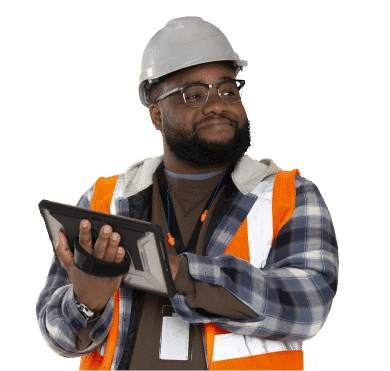Like construction, the oil and gas industry is complicated. It requires precise coordination among many project stakeholders to make for a profitable enterprise. And as international competition continues to put pressure on oil and gas firms in North America, firms in the region are constantly looking for ways to gain an edge.
Technology, specifically digital markup and collaboration tools like Bluebeam, has increasingly delivered that edge for the oil and gas industry. Built spoke with Duane Gingras, project engineer at Edmonton, Alberta-based Bantrel Co., about the critical challenges the industry faces, as well as how continuing advances in technology will help it thrive far into the future. Edited excerpts follow.
Built: What inspired you to get into oil and gas and the work that you’re doing?
Gingras: Because I live in Alberta—that’s what we do. Our industry here is oil and gas. My actual origins, because my first degree was cellular biotechnology, so my original game plan was to get into the remediation side. But there’s not a lot of business on the remediation side, and so the opportunities that presented themselves were of course in the oil and gas industry.
Built: Did you grow up in Edmonton, and did you have other family members in oil and gas before you?
Gingras: No. I grew up on a farm outside Edmonton. The rest of my family is in the trades, and I just took the black sheep route. I was the only one that went to university, started with sciences, and then went into engineering.
Built: What would you say is your favorite part of working in the industry?
Gingras: Prior to being in project engineering, I was in process engineering, and it’s really just the problem solving every day. Especially when you get into the live facilities, there’s always an issue that comes up that sometimes has a very straightforward solution, and sometimes requires a little bit of investigation. And it’s nice to be in a career that you get to exercise your brain a little bit vs. just project engineering where you don’t solve as many problems as you shepherd cats every day.
Curious why 3 million AECO professionals worldwide use Bluebeam to finish projects faster?

But the work from the academic point of view is good. Most people that go into engineering like working with numbers, and certainly once you start in that career, you get to maintain that habit when you’re doing a lot of calculations and exercising your abilities that you learned in school. But you get to apply it to real-world solutions, and you get to see some of your projects come to life.
Built: What would you say are some of the big trends in oil and gas right now that are keeping folks like you up at night?
Gingras: Speed is a big issue right now. We have opportunities to become more efficient as we deal with competition from international parties. We have lower wage rates in other countries that compete in the same market now, and given the cost of living in either the United States or Canada, it’s difficult to accommodate based on wage rates. And so you have to compete now in terms of efficiency and speed. So we’re constantly looking at ways that we can find time reduction, and I mean that’s one of the main reasons why we picked up Bluebeam in the past was for time reduction.
Built: What’s been the biggest noticeable change in terms of how technology has changed your job in the past 20 or so years you’ve been in the field?
Gingras: Certainly in the last 20 years there’s been huge time reductions, and we take it for granted now the amount of time that we have already cut out of our workflows. Anybody in oil and gas, or in the architectural side, will immediately chime in as well, just the transition from paper to digital in the time saved there. The common arguments that we get is that, “Oh, it takes about the same amount of time to do the markups in Bluebeam as it does on paper, which is more or less true; there’s some exceptions. But the amount of time to pass that information around, or to make revisions and updates to it, is significantly different.
Going from a paper-based system where you had to mail it to perhaps another drafting company someplace else or do large format scans where somebody had to walk to another part of the building to spend their afternoon scanning sized drawings, there’s no comparison there anymore where now you just do your markups electronically and send them on. And again, this is just one step as part of the whole, because you’re also dealing with improvements in your office infrastructure. Microsoft has come a long way with their Office 365, and their Azure platform just for interoffice collaboration, moving away from LAN-based systems into SharePoint-based systems. which give you automatic version history, control and forensic auditing capabilities that you never have dreamed of in the past.
Having a project engineer come up to you, and say, “I need to have a copy of all the drawings that were in existence six months ago.” You can do that now with a very quick query to SharePoint; you can pull out all the drawings that were in existence at the time six months ago, which you could never do that with paper in a timely fashion. So all these little steps have been adopted, and there’s been massive time reductions, but it’s just taken for granted now, and it’s still not fast enough.
Built: Where do you see technology evolving in your field? Everybody seems to be talking and buzzing about the potential of AI, for instance. Is that something that your colleagues are actively talking about? Is there an application?
Gingras: To an extent. We see some limited applicability to AI because, again, AI is not smart. It perhaps gets a false representation as being this magic bullet to providing this synthetic intelligence to what we do. But to me, it’s a fancy search engine more or less right now. And we do see some applicability in terms of helping us work with some databases that as a human it’s a little bit harder to dig through. So we’re trying to explore some opportunities here that can make better use of data that we currently collect, but we never go back and reference because as a person it’s just too much volume.
But I think something on an AI basis would allow us to deep dive into this data on a more ad hoc basis, or what would be a better word, something more artistic free form, where I could give it a question, and allow the AI to extrapolate on that question to see if it can dig up results that I wouldn’t normally think of, making the connections to. Because again, we are on front end engineering design; if I was in a live facility or something, and I’m sure there’s lots of companies looking into this, but having AI work on the process data that’s collected from a live refinery. And I’m sure companies like Emerson and others are actively exploring the opportunities that AI might give in process improvements on a live facility.
But in terms of other technologies, the ones that I see for us is really taking BIM to the next level. And not so much having AI in there, but it will never compete with the human brain in terms of creativity, despite what fancy pictures are being made by AI these days. But our ability to connect random thoughts together is still pretty important in our field of work. And as BIM has improved over the last decade or so, and we move into more of a model-based design principle, I think we’ll have a lot of improvements from technology there.











